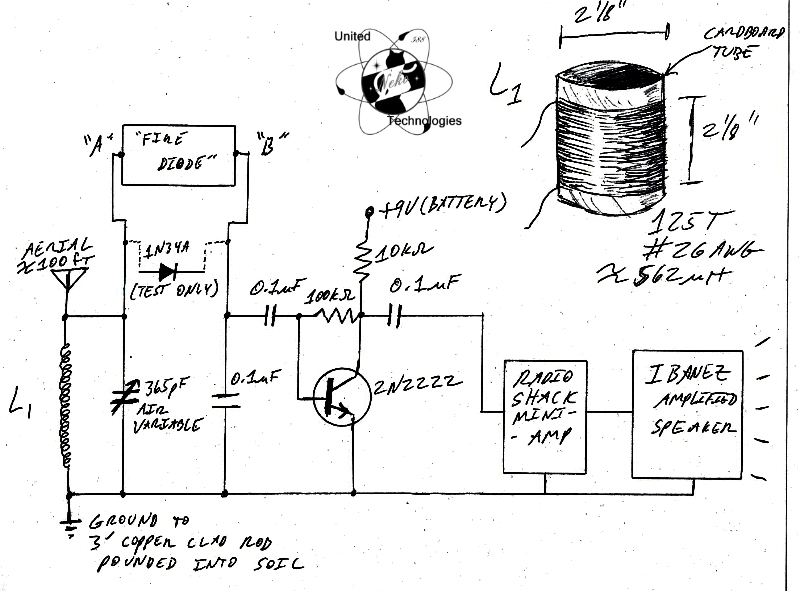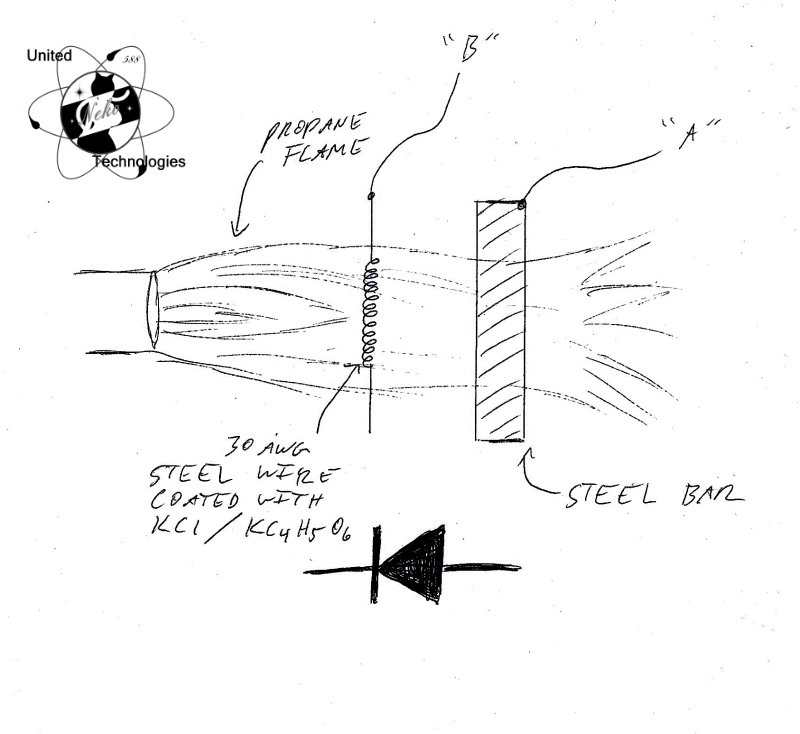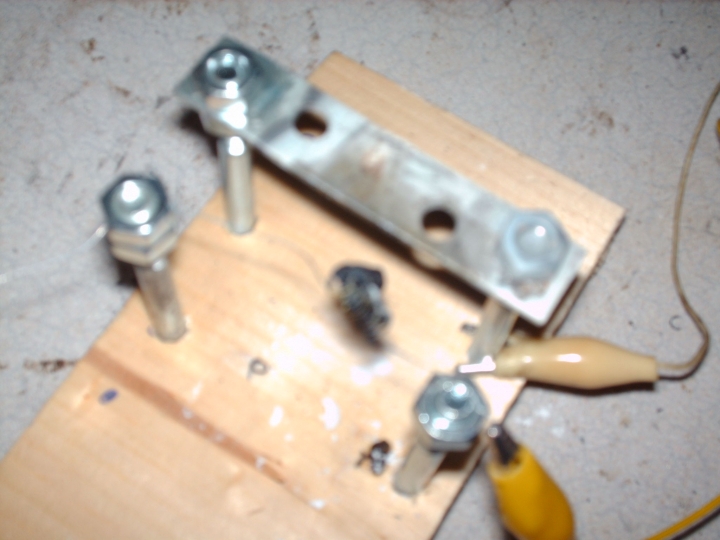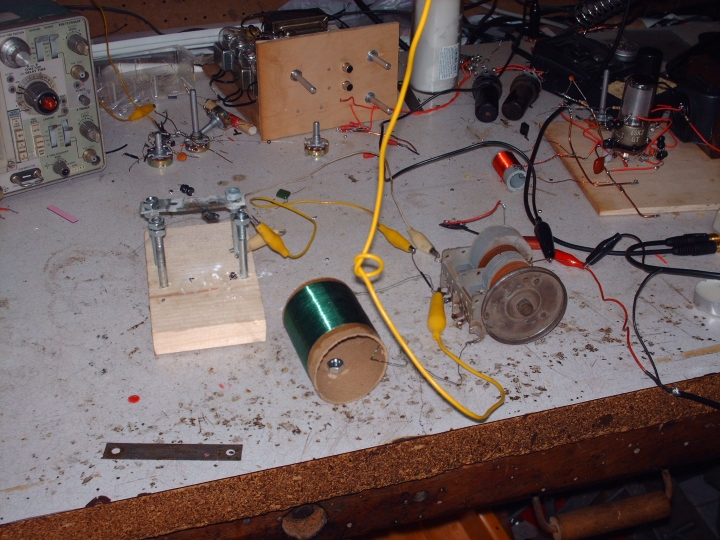
Among the earliest and still easiest constructed forms of radio receiver is the simple crystal set. Requiring at best, no power input, at worst, nothing more than a transistor battery for an amplifier, the simplicity and seeming 'magic' of the device is unparalleled. The experimenter can easily construct a crystal radio with but a handful of parts, all easily obtained, save perhaps one.
The coil can be made of anything cylindrical, such as a cardboard tube, PVC pipe, etcetera. Wire is easy to find, and the kind for this application is not critical. A handful of capacitors and resistors can be obtained from junk equipment, or just bought from the nearest Radio Shack (this assumes that "The Shack" will continue to stock things other than cellular phones and other crap). The tuning capacitor can be robbed from a cheap AM radio. And if a transistor amp is desired, any small NPN transistor will do fine. A set of high impedance earphones or an amplified speaker can be added, and you've built yourself a radio.
Well, almost. You need the crystal. This is simply a diode, which rectifies and 'detects' the minute RF waves propagating happily along until they strike the aerial of the receiver and end up meandering about in the tank circuit. A conventional silicon diode will not work well. Traditionally, a germanium point contact diode is used, of which the 1N34A is a relatively common example. I say relatively with strong emphasis; if you want one, you'll likely have to mail order for them.
You could also go the stone-age route, which is more romantic anyways, and construct your own point contact diode from certain semiconducting crystals. Galena is a good choice. Iron Pyrite will work. Bornite (commonly called 'peacock ore') sometimes works. Or you can make your own stuff, as Nyle Steiner has done.
But, upon reading further on Nyle's page, you might come across his experiments concerning a flame triode. On that page, he mentions flame detectors for use in crystal sets. Not having the article on hand, but intrigued by the prospect of a semiconductorless, vacuum-tube-less radio receiver, I set to work attempting to create a flame diode of my own.
A simple crystal set, of a common design, was constructed using whatever treasure (read: junk) we at United Neko had laying around. I had a 1N34A on hand for test purposes, so that made life simpler. The coil was already wound for something else, and was utilized. An air-variable capacitor found from a wrecked Victrola was also on hand. In addition to the simple NPN preamplifier in the circuit, the audio was sent to a Radio Shack minispeaker amplifier, and then to an Ibanez guitar amplifier (provided courtesy of my wife and her guitar). The aerial used was a horizontal long wire antenna, strung from the inside of United Neko's lab to a tree approximately 100 feet away. RF ground was conveyed through a heavy, braided copper wire bundle to a copper clad steel grounding rod pounded three feet into the soil.
The schematic is below, with the understanding that the 1N34A is in circuit only for purposes of testing. When the device marked "fire diode" is used, the 1N34A is removed entirely from the circuit.

The local radio station here in Buffalo, New York was dominating almost the entirety of the crystal set's tuning range. A nice example of blocking. But for our purposes here, this isn't a problem, and is perhaps beneficial. 930kcps AM, WBEN was to be our litmus test of whether or not a flame diode could work. With the 1N34A in place, the station came in crisp and clear, with excellent fidelity for so simple a setup. Time to proceed to the real thing.
The flame diode was constructed as per this illustration:

The anode is constructed of a piece of steel, about 1/16" thick, a couple inches long, and 1/2" wide. The reason so heavy a steel anode was chosen will be explained later. The cathode was composed of a coiled filament of thin (30AWG) Monel steel wire. This is not necessary, however; it is just what I had the most of. Regular steel will work just fine. It will not, however, work properly unless given a coating of some material which generates ions in the applied propane flame. Three materials were tried; NaCl, conventional table salt, KCl, a salt substitute, and potassium bitartrate (cream of Tartar), as Nyle Steiner suggested. The best results in my setup were obtained with a combination of KCl and potassium bitartrate. The cathode filament was wetted and then immersed in the powder of the two salts, which adhered to it. It was then positioned in front of the steel anode. The propane flame was then applied, heating the cathode filament to incandescence and bathing the anode in diffuse flame. Some photographs of the setup are below.



When this was done, the reciever had power applied, and the amplifier was running. I was pleasantly surprised to hear WBEN 930AM suddenly emerge, in excellent fidelity, from the speaker! Truly, a flame radio can be made to work, and quite well. This video demonstrates the operation and output of the receiver. Yes, it is impractical. Yes, it is a fire hazard if used carelessly. But it is a radio which, aside from (unnecessary if crystal 'phones are used) simple audio amplification, uses no tubes and no semiconductors!
Perhaps the most interesting part of this experimentation was the trial and error process. I learned a few things along the way which may help those who wish to reproduce this, and I hope, take it even farther. For one thing, the first attempt used identical materials for anode and cathode, aside from the 'salting' of the cathode. It worked... but for mere seconds. Thinking the diode had been destroyed by heat, I shut the blow torch down, and thought about why it could have failed. I then tried once more, reapplying heat. Again, WBEN greeted me... but for less than 5 seconds. What was happening? I then thought of the vacuum tube, how a troublesome effect known as secondary emission could sometimes appear. Now, if unwanted emissions from the plate (anode) of a vacuum tube could happen, could it happen in my flame diode? I reapplied flame and listened, noting exactly when the station faded away... it coincided nicely with the steel anode wire reaching incandescence. Ah, a heavier anode is needed, to avoid becoming so hot. Thus, I used the heavier steel plate. Now only the cathode wire was incandescent, and the radio station was loud and clear as long as flame was applied.
Another thing I noticed; if there is no physical connection of the cathode and anode with the flame, there is little or no radio detection. This was interesting, considering that Nyle Steiner's flame triode worked with an anode outside of the flame; could it have to do with the fact that in his setup, higher bias voltages were used, whereas in my detector setup, the only obvious external source of voltage across the 'diode' is that induced by passing RF?
It will also not work backwards! In another test, I moved the position of the blowtorch flame by 180 degrees, the flame now playing first across the anode, and then across the cathode. All else was equal; the cathode was heated to the same incandescence, the flame connected both cathode and anode. Nothing was detected whatsoever. Why? When the torch position was reversed, blowing from cathode to anode, detection resumed, and the loud sound of the AM giant was again heard. Could it be that the physical motion of the ionized gas, ions of the cathode salts, and/or electrons is important in achieving successful rectification? Is the torch flame literally forcing current flow? It is interesting to note that, in adjusting the propane torch's flame setting, the flame magnitude (and thus velocity) had more effect on volume produced from the receiver than did minor variances in cathode temperature, as judged by color of incandescence.
Where do I proceed from here? After all, this is just a lab curiosity, and highly impractical.
But then again, the most impractical things in life are sometimes the most entertaining. I hope you've enjoyed this as much as I did in performing the experiment, and I ask that, should you try it for yourself and find something I haven't mentioned here, that you let us know.
Last updated May 17, 2010
This Web Page Created with PageBreeze Free HTML Editor